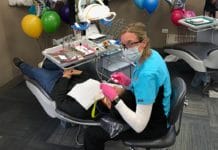Dental public health focuses on preventing and controlling oral diseases through organized community efforts. It includes “oral health education of the public, applied dental research, the administration of group dental care programs, and the prevention and control of oral diseases at the community level.”1
I asked Paula Morrison, RDH, BS, the same questions from my previous interview, What Other Hygienists Do: A Look at Care Behind Bars. Paula has been a dental hygienist for over 15 years. More specifically, Paula works in a school-based dental program. I wanted to dive in deeper and learn how Paula got to the hygiene position she works in today.
School-Based Dental Health
Kaitlyn: How many years have you been a hygienist, and what do you do in this work setting?
Paula: I have been a hygienist for 16 years and work for a community health center as a hygienist in their school-based dental program. Our program provides the following services: dental exams, hygiene treatment, sealants, fluoride varnish, and radiographs. We educate students while we have them in our chairs, and we hope to add a restorative component to the program soon. The community health center is responsible for billing out for services rendered.
Kaitlyn: How did you get to this position?
Paula: A dental hygiene friend of mine told me that there was a position available for this particular job. It’s all about networking!
Kaitlyn: Why did you decide to work in this setting?
Paula: I started working in the school setting after graduating from dental hygiene school and decided to do this because it was a part-time position that fit my schedule. The job was available in the city where I grew up, so I was familiar with all the schools in the area. Since then, I have worked in the schools for all of my career and will continue to do so as long as possible!
Kaitlyn: What are some things you would like others to know about hygienists in this specific work setting?
Paula: We are a dedicated and committed team of hygienists who love to provide services to children in the schools. We are flexible and accommodating and truly enjoy providing these services to children who may not otherwise receive dental care. Everyone working in the program is very aware of the problem areas in our schools. Because our program has been in existence for so long, we are definitely aware of the needs and priorities.
We also work with two dentists and one dental assistant. Our program has been in this community within the schools for approximately 20 years. We also work with the school nurses to ensure they know the students’ dental needs. The program calls the parents and tries to schedule them with the health center if they do not have a dentist of record or get them back to their own dentist if they have one.
We provide services that I previously mentioned, just like any dental office. Scheduling school visits can have its challenges. We try to visit most elementary schools up to three times per school calendar year if time permits and twice a year for middle and high school levels.
Additionally, our program keeps a log of needed restorative treatment so that we can check to see if the parents followed up between visit one and visit two.
Kaitlyn: How is this work setting different than other settings in the dental hygiene profession?
Paula: For starters, the schedule is one of the differences. You need to be flexible, and you may not have the option to work full-time because the job follows the school year calendar. I work the same schedule as the schools, which means I also have all holidays, vacation weeks, and summer vacation time off. Some hygienists may prefer to work full-time year-round, so a school schedule may not accommodate their needs. We base our schedule by going into the schools with the most needs first so that we can possibly get there three times a year.
Traveling is another difference. We travel to approximately 40 different schools in five different towns. You need to like to be moving around in this job! Carrying portable equipment is required and it can be heavy. The dental works unit weighs 46 pounds, and the portable dental chair weighs 30 pounds. Moving equipment in and out of schools in all kinds of weather may not be for everyone. This is a portable dental program, so it is like having a dental office on the road.
Setting up equipment in a school can vary from school to school. It all depends on where the school has available space. We have set up in many different areas, including all of the following: in an open available classroom, in the nurse’s office, in the gym, on a stage in the auditorium or cafeteria, in the library, in the hallway, or even under a stairwell. Once we are set up in the location, we can typically stay there until we finish seeing all the children. However, we have had to break down and set up in another location within the school if the space we are using is needed for something going on in the school.
Kaitlyn: Are there any specific requirements that are needed to work in this specific setting?
Paula: No, there are no specific requirements other than being a dental hygienist. I work for a community health center, which is a little different than working as a public health dental hygienist who owns their own business.
Kaitlyn: Are there any other comments or info you would like to add regarding your dental hygiene career or job position?
Paula: This job is very rewarding, and I love making a difference in children’s oral health. The work is hard, but I love what I do!
In Closing
Providing dental treatment in a school-based setting is only one example of the many setting types a hygienist can work. A big thank you goes to Paula for taking the time to share her career path!
Before you leave, check out the Today’s RDH self-study CE courses. All courses are peer-reviewed and non-sponsored to focus solely on pure education. Click here now.
Listen to the Today’s RDH Dental Hygiene Podcast Below:
References
- Dental Public Health Residency (DPHR) Program Frequently Asked Questions. (2023, July 18). Centers for Disease Control and Prevention. https://www.cdc.gov/oralhealth/about/DPHR-faqs.html












